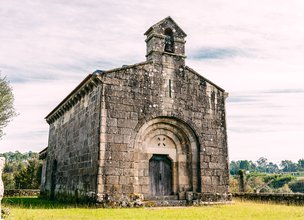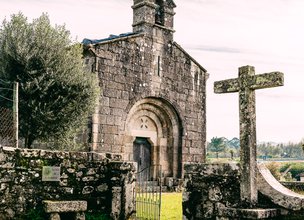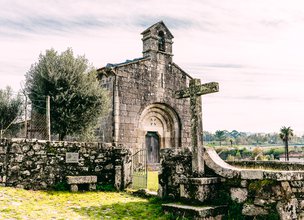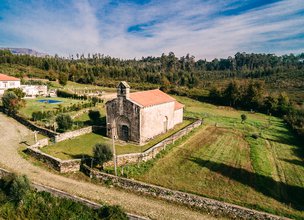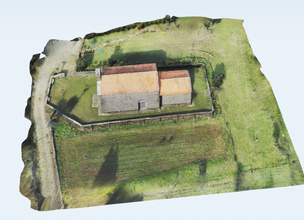This church of an old Benedictine monastery, classified as a National Monument since June 16, 1910, is a remarkable example of Romanesque architecture, standing out for the diversity of decorative solutions it presents, reflecting successive restorations and extensions that have been going on over time. Having a very common plan, with a single nave, headed by a chancel in the form of an elongated rectangle, this church presents very sober architectural solutions, with three entrances without columns and a decorative rule that, with the exception of the dogs, presents parallels with the region of Braga, specifically with the churches of Bravães, Arõese Sé de Braga. In addition to the dog ornamentations, quite expressive and denoting Galician influences, the main door's tympanum, decorated with a hollow cross marked by two zoomorphs, stands out, as well as an epigraph that refers to the year 1201 as the date on which the temple was consecrated by the Bishop of Tui, D. Pedro. Although the precise moment for the construction of this conventual church is unknown, several inscriptions refer to the dates of 1082, 1145 and 1183, as well as some decorative details of the arch-crossing, with Mozarab art imitations, seem to want to tell us that there was another building, prior to that which the Bishop of Tui consecrated at the dawn of the 13th century. Also the Gothic era was responsible for some changes that the church underwent, namely in terms of the nave and the chancel which are documented by a large number of acronyms from that time. These successive transformations were not unconnected with the enormous development that the Limiana Basin underwent in the Middle Ages and which was responsible for the increase in the economic power of the Monasteries, allowing them to build new temples or to expand the existing ones.
This church of an old Benedictine monastery, classified as a National Monument since June 16, 1910, is a remarkable example of Romanesque architecture, standing out for the diversity of decorative solutions it presents, reflecting successive restorations and extensions that have been going on over time. Having a very common plan, with a single nave, headed by a chancel in the form of an elongated rectangle, this church presents very sober architectural solutions, with three entrances without columns and a decorative rule that, with the exception of the dogs, presents parallels with the region of Braga, specifically with the churches of Bravães, Arõese Sé de Braga. In addition to the dog ornamentations, quite expressive and denoting Galician influences, the main door's tympanum, decorated with a hollow cross marked by two zoomorphs, stands out, as well as an epigraph that refers to the year 1201 as the date on which the temple was consecrated by the Bishop of Tui, D. Pedro. Although the precise moment for the construction of this conventual church is unknown, several inscriptions refer to the dates of 1082, 1145 and 1183, as well as some decorative details of the arch-crossing, with Mozarab art imitations, seem to want to tell us that there was another building, prior to that which the Bishop of Tui consecrated at the dawn of the 13th century. Also the Gothic era was responsible for some changes that the church underwent, namely in terms of the nave and the chancel which are documented by a large number of acronyms from that time. These successive transformations were not unconnected with the enormous development that the Limiana Basin underwent in the Middle Ages and which was responsible for the increase in the economic power of the Monasteries, allowing them to build new temples or to expand the existing ones.
Location
União de Freguesias de Nogueira, Meixedo e Vilar de Murteda
Coordinates
Lat: 41.7299389
Long: -8.7251694
Hello little one!
I'm Piquinhos and I can help you learn more about the Geopark!
Technical details
Child Mode
Discover the geopark in a simpler format, aimed at the little ones.
Clique ENTER para pesquisar ou ESC para sair
